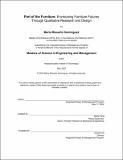Part of the Furniture: Envisioning Furniture Futures Through Qualitative Research and Design
Author(s)
Risueño Dominguez, Maria
DownloadThesis PDF (19.74Mb)
Advisor
Yang, Maria
Terms of use
Metadata
Show full item recordAbstract
Furniture is a bridge between our bodies and the world. Through furniture, we can live in a way we wouldn't otherwise be able to. Since we’ve evolved into humans, we've become designers and consumers of furniture – from the rocks in ancient caves to King's thrones to the millions of couches worldwide: furniture is our tool for living. Chairs, tables, beds...hundreds of objects surround us in our everyday lives, yet how much time do we spend rethinking them? The phrase being [part of the furniture] refers to something that has been somewhere so long to seem a permanent, unquestioned, or invisible feature of the landscape. Part social and behavioral research project and part furniture design exploration, this thesis aims to understand what furniture means to people and invite us to challenge and rethink what we know about furniture and envision new ways of designing it in the future.
8 out of 10 furniture pieces end up in landfills during their lifetime. The sustainability of furniture is a complex issue due to its multifaceted nature. It involves not only material selection, recyclability, and quality standards, which impact longevity, but also consumer behavior, emotional needs, and furniture disposal. To understand what we can do to tackle this challenge we reviewed relevant literature across disciplines and conducted qualitative field research. Our review examines such factors as emotional durability, product attachment, material perception, and adaptability as different approaches to extending longevity. More in-depth interviews were conducted with furniture users and stakeholders in the furniture industry including subject-matter experts.
This research aims to identify the gap between our furniture needs and the products available on the market. To understand this gap, we first looked at how people think about furniture and what they value. Secondly, we identified current practices and implications in the furniture industry. Thirdly, we explored areas of opportunity for the future of furniture. In the study, adaptability and the ability to change furniture over time were the top needs among furniture users. Industry stakeholders recognized longevity as a critical opportunity in the future. Yet, so much of the furniture we see on the market does not reflect these needs.
Along with this thesis document, we envisioned a system of products that proposes an alternative way of thinking about furniture. We developed experimental prototypes of long-lasting furniture joints that allow for multiple affordances, adapting to different functions and needs over time. As the industry moves forward, new challenges will arise; this study identifies opportunities for developing designs, marketing, and imaging furniture in the future.
Date issued
2022-05Department
System Design and Management Program.Publisher
Massachusetts Institute of Technology